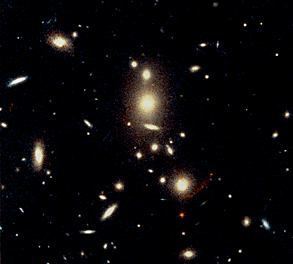![[Currents header graphic]](/homeart/currents_header.gif)
![[Currents header graphic]](/homeart/currents_header.gif)
August 18, 1997

|
|
Image of distant galaxy
|
By Ray Villard
Public affairs officer, Space Telescope Science Institute
An international team of astronomers has discovered the most distant galaxy found in the universe to date by combining the unique sharpness of the images from NASA's Hubble Space Telescope with the light-collecting power of the W. M. Keck Telescopes--with an added boost from a gravitational lens in space.
The results show the young galaxy is as far as 13 billion light-years from us, based on an estimated age for the universe of approximately 14 billion years. This would place the galaxy far back in time during the "formative years" of galaxy birth and evolution, less than a billion years after the birth of the universe in the Big Bang.
The detailed image shows that bright dense knots of massive stars power this object. Due to the firestorm of starbirth within it, the galaxy is intrinsically one of the brightest young galaxies in the universe, blazing with the brilliance of more than 10 times our own Milky Way (more photos).
"We are fascinated to be witnessing the very early stages of the construction of what could well become a massive galaxy like our own Milky Way," said Professor Garth Illingworth of UC Santa Cruz, an astronomer at the UC Observatories/Lick Observatory. "This object is a pathfinder for deciphering what is happening in young galaxies, and it offers a rare glimpse of the powerful events that transpired during the formation of galaxies."
"We were excited by the possibility that we may have found a unique example of a galaxy in formation at the time of the earliest quasars," said astronomer and collaborator Marijn Franx of the University of Groningen in the Netherlands.
Predicted by Einstein's theory of general relativity, gravitational lenses are collections of matter (such as clusters of galaxies) that are so massive they warp space in their vicinity, allowing the light of even more distant objects to curve around the central lens mass and be seen from Earth as greatly magnified.
The object is so far away, observing it in such detail would tax the capabilities of both Hubble and Keck without the magnification of the gravitational lens, provided by a foreground cluster of galaxies that is much closer to us at 5 billion light-years.
Due to a rare and fortunate alignment of the young galaxy behind the foreground cluster, astronomers gain a magnified view that is 5 to 10 times better than Hubble alone can yield for an object at such a great distance. A telltale sign of the lensing is the smearing of the remote galaxy's image into an arc shape by the gravitational influence of the intervening galaxy cluster.
The smeared image of the galaxy stood out because of its unusual reddish color. "Such magnified galaxies had been observed before, but never with such a color," said Franx. "The special color of the galaxy in the arc is due to absorption by the matter in the universe between us and the galaxy and suggested to us that it was at a great distance."
The suspected remoteness of the lensed object was confirmed when the team of astronomers made spectroscopic observations with one of the twin 10-meter Keck Telescopes on Mauna Kea, HI, to measure its redshift, and therefore its distance, based on the shifting of its light toward the red end of the visible light spectrum. The resulting high redshift (z=4.92) corresponds to a very early era when the universe was just beginning to form galaxies.
Though candidates for still more distant objects have been proposed, they have not been confirmed spectroscopically. The previous most distant known object was the quasar PC1247+34 (z=4.90).
"Based on this image we can begin to make some conclusions about the early growth of galaxies," said Illingworth. "The knots show that starbirth happens in very tiny regions compared with the size of the final galaxy." This helps clarify the astronomer's view of the formation of galaxies as occurring within a cauldron of hot gas, with knots of intense star formation, strong winds, and "mergers"--collisions of the dense star-forming knots.
Using Keck's spectroscopic capabilities, the astronomers have also, for the first time, been able to measure the motions of the gas within such a distant galaxy. The observations reveal gas flowing at nearly 500,000 miles per hour (200 km/sec), presumably accelerated by energy from supernova explosions going off like a string of firecrackers.
"The strong winds that we observe suggest that galaxies may lose a lot of material when they are young and thereby enrich the empty space around them," said Franx. "Many astronomers had speculated about the existence of such winds in such distant galaxies, and we now have an object where we can see them directly. It is striking that the most distant galaxy found to date is also the one that provides us the most detailed picture of events in such distant galaxies."
The Space Telescope Science Institute is operated by the Association of Universities for Research in Astronomy, Inc. (AURA) for NASA, under contract with the Goddard Space Flight Center, Greenbelt, MD. The Hubble Space Telescope is a project of international cooperation between NASA and the European Space Agency (ESA). The W. M. Keck Observatory is operated by the University of California, the California Institute of Technology, and NASA.